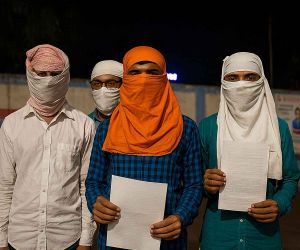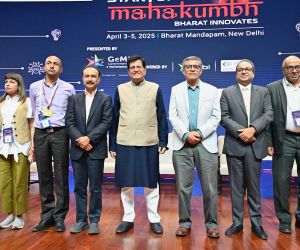MORE COVERAGE
Twitter Coverage
Satyaagrah
Written on
Satyaagrah
Written on
Satyaagrah
Written on
Satyaagrah
Written on
Satyaagrah
Written on
JOIN SATYAAGRAH SOCIAL MEDIA
“It’s not the destination, it's the journey”: India becomes 2nd-largest country with the biggest road network after beating China with total road network of 63.32 lakh km comprising all categories - national & state highways and urban & rural roads

India, the land of diverse cultures and vibrant landscapes, now boasts of an extensive network of national highways that is the second largest globally, superseded only by the United States. This rapid infrastructural development, a product of the ambitious vision of the Modi Government, underscores the nation's dynamic spirit and its relentless stride towards a more connected and efficient future.
|
The Union Minister for Road Transport & Highways, Nitin Gadkari, announced this achievement on Tuesday, instilling a sense of pride and excitement in the hearts of every Indian.
Over the last nine years, under the NDA government, the national highway network has undergone a substantial expansion, witnessing a growth rate of 59%. As of today, the sprawling network stretches over 1.45 lakh km, marking an exponential increase from the figures that stood during the pre-Modi era. This significant milestone resonates with the transforming image of India, reflecting its robust economic growth, technological prowess, and infrastructural capabilities. Moreover, it signifies a transformational shift in the nation's transportation landscape, paving the way for seamless connectivity and improved accessibility across the country's length and breadth.
Undoubtedly, such large-scale infrastructural development has a profound impact on the country's economic framework. The revenues generated from tolls serve as a testament to this fact. In FY23, the toll revenues skyrocketed to a whopping Rs 41,342 crore, a substantial leap from the Rs 4,770 crore registered in 2013-14. Furthermore, the government aims to propel the toll revenue to an ambitious target of Rs 1,30,000 crore by 2025, demonstrating an optimistic outlook towards infrastructural investment and growth.
In this era of fast-paced development, technology and innovation have emerged as crucial pillars supporting the infrastructural evolution. A prime example of this symbiosis is the implementation of FASTags across the nation's toll plazas. The introduction of this technology has remarkably reduced the waiting time at toll plazas to 47 seconds. Gadkari, during his press conference, highlighted the government's plans to further slash this waiting time to below 30 seconds, emphasizing the administration's commitment to promoting efficiency and productivity. By 2047, the waiting time at toll plazas is envisaged to be eliminated entirely, setting the stage for an era of seamless, uninterrupted travel.
|
Speaking about the country's infrastructural advancements, it's worth mentioning that the extent of 4-lane national highways has nearly doubled over the past nine years. From a relatively modest 18,371 km in 2013-14, the figure has surged to a staggering 44,654 km today. These numbers signify a nation on the move, steadily cruising along the highway of development and progress. Gadkari, seizing the opportunity, also invited investors to consider investing in NHAI INviT, which offers an attractive interest rate of 8.05 per cent, significantly outpacing traditional bank rates.
Taking a closer look at the industry scenario, it's evident that the Indian government has undertaken massive infrastructural initiatives. By allocating approximately $1.4 trillion for infrastructure investments until 2025, the government has unequivocally signaled its dedication towards enhancing the country's transportation infrastructure. Consequently, the market for roads and highways in India is projected to exhibit a robust CAGR of 36.16% during 2016-2025.
The highway sector in India, a beacon of performance and innovation, has witnessed numerous successful roll-outs of road projects. More than 60 road projects, valued over $10 billion, have been launched based on the Hybrid Annuity Model (HAM). This innovative model has adeptly balanced risk between private and public partners, fueling the surge in PPP activity in the sector.
Asset recycling, another prominent strategy, has been deployed through the toll-operate-transfer (ToT) model. The National Highways Authority of India (NHAI) has adopted this model for 100 highways, leading to successful monetization of the first two bundles of nine highways each, attracting an investment of over $2 billion.
Moreover, the NHAI has secured its place in the Guinness World Records twice. Once, by constructing a 75 km continuous Single Lane Bituminous Concrete Road in a record time of 105 hours 33 minutes, between Amravati and Akola on NH 53 in Maharashtra. And again, in collaboration with Maha Metro, by constructing the longest Double Decker Viaduct (3.14 km) with Highway Flyover & Metro Rail supported on a single column between three metro stations in Nagpur.
In one of the biggest reforms in the road transportation industry in India, the NHAI has gone 'Fully Digital'. It has launched a unique cloud-based and Artificial Intelligence-powered Big Data Analytics platform – Data Lake and Project Management Software. This transformative step has shifted the entire project management workflow of NHAI from manual to online portal-based operations, optimizing efficiency and enhancing transparency.
In conclusion, India's infrastructural growth story is a testament to the nation's ambition, determination, and resilience. As the country continues to build its path towards a more connected and prosperous future, the strength and expansiveness of its highway network remain key symbols of its progress. And as we traverse these highways, we can't help but marvel at the journey India has embarked on – a journey of development, unity, and unlimited possibilities. A journey that truly captures the essence of the 'New India' mood.
|
World's top 10 networks of national highways
The world's top 10 networks of national highways are a testament to human ingenuity, economic development, and the desire for connectivity. These expansive networks of highways, expressways, and local roads not only facilitate transportation but also serve as vital arteries for trade, commerce, and cultural exchange. This article will delve into the details of these impressive road networks, their unique features, and the countries that host them.
United States of America - The United States boasts the world's largest network of national highways, spanning over 6.58 million kilometers. This vast network is a testament to the country's economic wealth and its commitment to connectivity. The US road network includes interstate highways, state highways, and local roads that traverse diverse landscapes, from the golden plains of the Midwest to the bustling cities on the coasts.
India - With a network of national highways spanning over 1.45 lakh kilometers, India holds the second spot. The country's rapid economic development over the past few decades has been mirrored in its infrastructure growth. India's road network is a mix of expressways, national highways, and local roads that connect its vast territories and bustling cities. The Indian government has also implemented measures such as the use of FASTags to reduce waiting times at toll plazas, aiming for a completely seamless experience by 2047.
China - China's network of national highways, the third-largest globally, exceeds 4.24 million kilometers. The country's road network has been a key factor in its remarkable economic development, connecting its major cities and facilitating trade and commerce.
Brazil - Brazil's network of national highways, the fourth-largest in the world, covers approximately 1.75 million kilometers. The country's road network is a crucial component of its economic infrastructure, facilitating the movement of goods and people across its vast territory.
Japan - Japan's network of national highways, covering 1.21 million kilometers, is the fifth-largest globally. Despite the country's relatively small size, its dense network of roads reflects its highly urbanized population and advanced economy.
Canada - Canada's network of national highways, the sixth-largest in the world, covers 1.04 million kilometers. The network spans the country's vast territory, connecting its major cities and facilitating access to its abundant natural resources.
Russia - Russia's network of national highways spans more than 982,000 kilometers, making it the seventh-largest in the world. The network's size is a testament to the country's vast geographical expanse and the need for connectivity across its diverse regions.
France - France's network of national highways, the eighth-largest globally, spans 951,200 kilometers. The network is a crucial part of the country's infrastructure, connecting its major cities and facilitating tourism and commerce.
Australia - Australia's network of national highways, the ninth-largest in the world, measures over 823,217 kilometers in length. The network spans the country's vast outback, connecting its coastal cities with remote interior regions.
Spain - Spain's network of national highways, the tenth-largest in the world, spans over 681,298 kilometers. The network connects the country's major cities and tourist destinations, playing a crucial role in its economy.
In conclusion, the world's top 10 networks of national highways are a testament to the importance of infrastructure in economic development and connectivity. These networks facilitate the movement of goods and people, contributing to the wealth and prosperity of their respective countries.
 Support Us
Support Us
Satyagraha was born from the heart of our land, with an undying aim to unveil the true essence of Bharat. It seeks to illuminate the hidden tales of our valiant freedom fighters and the rich chronicles that haven't yet sung their complete melody in the mainstream.
While platforms like NDTV and 'The Wire' effortlessly garner funds under the banner of safeguarding democracy, we at Satyagraha walk a different path. Our strength and resonance come from you. In this journey to weave a stronger Bharat, every little contribution amplifies our voice. Let's come together, contribute as you can, and champion the true spirit of our nation.
 |  |  |
| ICICI Bank of Satyaagrah | Razorpay Bank of Satyaagrah | PayPal Bank of Satyaagrah - For International Payments |
If all above doesn't work, then try the LINK below:
Please share the article on other platforms
DISCLAIMER: The author is solely responsible for the views expressed in this article. The author carries the responsibility for citing and/or licensing of images utilized within the text. The website also frequently uses non-commercial images for representational purposes only in line with the article. We are not responsible for the authenticity of such images. If some images have a copyright issue, we request the person/entity to contact us at satyaagrahindia@gmail.com and we will take the necessary actions to resolve the issue.
Related Articles
- Bangladesh and India put the final nail in the coffin of China’s ‘String of Pearls’ with access to Chittagong port as it was offered by PM Sheikh Hasina for use by India for trade and uninterrupted commerce
- Western sanctions on Russia, with 19,535 measures imposed since 2022, aimed to cripple its economy but instead drove alliances with China, India, Iran, and North Korea, boosting trade, diversifying its economy, and weakening Western dominance
- Semiconductor Titans, Micron, Applied Materials, and Lam forging robust alliances with India, unveiling monumental billion-dollar investments to significantly bolster India's Semiconductor Mission and usher a future of unprecedented tech advancements
- Anthony Blinken delusional about US primacy over world affairs made schoolmasterish remarks, “US monitoring human rights abuses in India”: Lutyens elites and the editors of India’s English-language media outlets lap it up
- "Greed's frontier: The harsh truth of expansionism": Amid the furore over China releasing a new map, Ex-Chief of Army Staff General Manoj Naravane shared a map of China and took a dig saying "finally someone has got the map of China as it really is"
- "New dynamism in ties": In Jakarta, PM Modi calls for a new rules-based order in the post-Covid era, emphasizing the critical role of the ASEAN-India partnership in shaping the resurgence of Asia in the 21st century and fostering global growth
- "Unity in strategy, strength in partnership": Amid China's rising influence in the Indo-Pacific, Germany strengthens military relations with 'reliable' India, eyeing secure trade routes and strategic collaborations while stepping up military ties
- Negative sentiments about China and Xi Jinping at a record high among most advanced countries: Pew Research study
- Terrorism, Pakistan, COVID, Afghanistan and more: Here’s all that PM Modi and US VP Kamala Harris discussed in the bilateral meet
- World’s highest tunnel to be built by BRO to connect Himachal Pradesh and Zanskar valley in Union Territory of Ladakh; will ease movement of the Indian Army vehicles: Director-General of BRO, Lt Gen Rajeev Chaudhary
- "Connectivity is power; India realizes it first": India takes the lead in the Himalayan railway race, outpacing China in connecting with Nepal, amid geopolitical intricacies, as the tracks extends, Nepal emerges as a crucial nexus in this Asian power play
- Konark Chakra - Bharat’s Chariot of Progress at G20 Summit echoes our vibrant journey, a harmonious blend of rich heritage and dynamic innovation, steering the nation towards a bright, inclusive future on the global stage, fuelled by cooperation & harmony
- Explained: China’s Village Construction In Bhutan’s Territory And What It Wants To Achieve With This Creeping Invasion
- Giant hypocrite: Activist confronts Twitter CEO over censorship, asks why he ‘hates Jews and Conservatives’
- "Create your own miracles; do what you think you cannot do": BRO's Engineering Marvels - Bridging Gaps, Transforming Lives in challenging terrain through crucial road networks, playing a vital role in national security, and fostering socio-economic growth

























